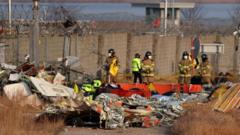The tragedy unfolded on Sunday morning when Flight 7C2216, a Boeing 737-800 returning from Bangkok, was cleared to land shortly before 9 AM local time. Three minutes after the clearance, air traffic control issued warnings concerning bird activity, and shortly thereafter, the pilot reported a bird strike while attempting to land. An emergency "mayday" call was made, leading to an aborted landing and a request to approach from an alternate direction.
At approximately 09:02, the aircraft touched down, but it failed to engage its landing gear and skidded off the runway into a barrier, erupting in flames. Eyewitnesses described hearing a loud explosion followed by smaller detonations, as rescue efforts commenced.
The aircraft was carrying 181 people, with 179 confirmed dead, making this the deadliest plane crash in South Korean history. Two crew members survived, having been found in the tail section of the aircraft. Authorities are actively collecting evidence, including flight data, while investigations probe possible causes such as a bird strike compounded by poor weather conditions.
Despite the tragedy, aviation experts highlight the rarity of bird strikes causing such catastrophic outcomes, suggesting that maintenance issues or other mechanical failures might also play roles. The Transport Ministry has confirmed that the lead pilot had over 6,800 hours of flying experience.
As the nation mourns, emergency inspections of airline operations across the country have been ordered, and Muan has been designated a disaster zone. Families of the victims wait anxiously for more news as the recovery and identification process unfolds, all amid a backdrop of collective grief and confusion regarding the circumstances leading to this horrific event.
At approximately 09:02, the aircraft touched down, but it failed to engage its landing gear and skidded off the runway into a barrier, erupting in flames. Eyewitnesses described hearing a loud explosion followed by smaller detonations, as rescue efforts commenced.
The aircraft was carrying 181 people, with 179 confirmed dead, making this the deadliest plane crash in South Korean history. Two crew members survived, having been found in the tail section of the aircraft. Authorities are actively collecting evidence, including flight data, while investigations probe possible causes such as a bird strike compounded by poor weather conditions.
Despite the tragedy, aviation experts highlight the rarity of bird strikes causing such catastrophic outcomes, suggesting that maintenance issues or other mechanical failures might also play roles. The Transport Ministry has confirmed that the lead pilot had over 6,800 hours of flying experience.
As the nation mourns, emergency inspections of airline operations across the country have been ordered, and Muan has been designated a disaster zone. Families of the victims wait anxiously for more news as the recovery and identification process unfolds, all amid a backdrop of collective grief and confusion regarding the circumstances leading to this horrific event.



















